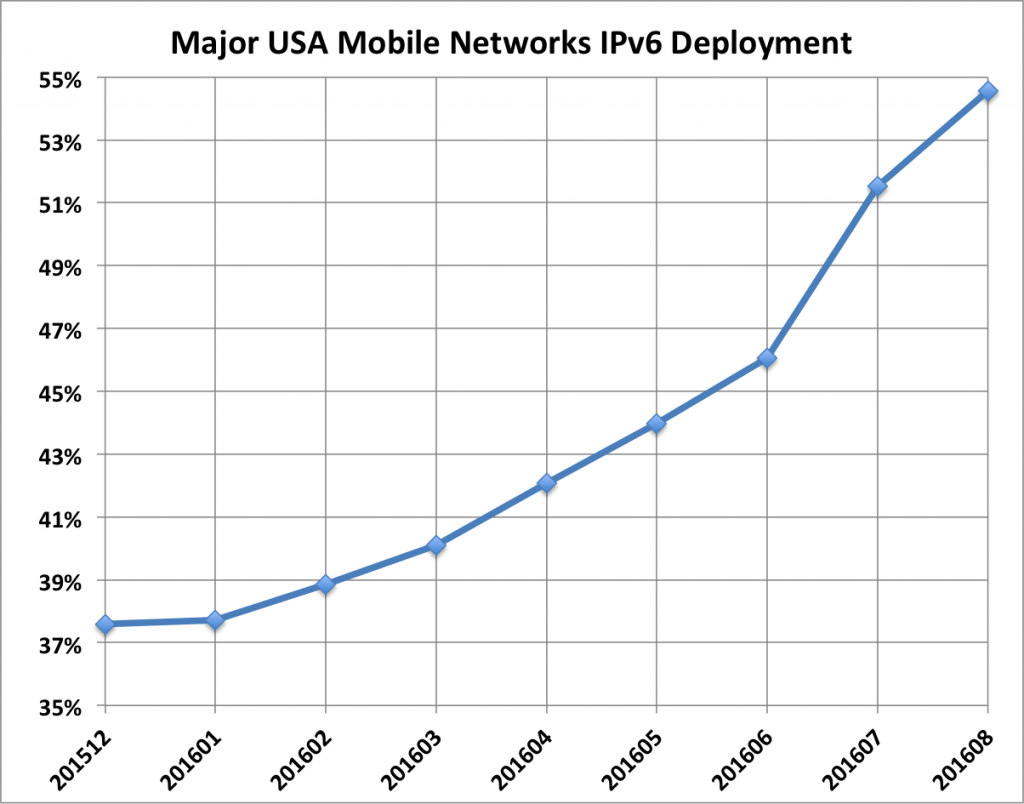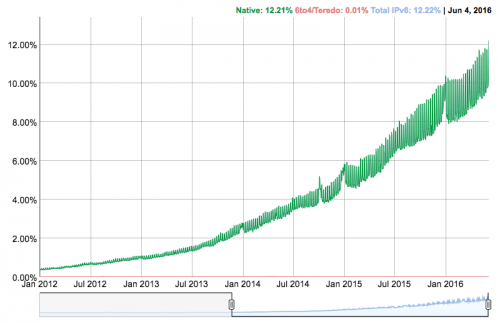In our year-end blogpost in December of 2015 we highlighted the enormous progress that IPv6 deployment had made in 2015 by obtaining aggregated data from our sources for the four major US mobile providers:
– Verizon Wireless (AS22394)
– T-Mobile USA (AS21928)
– Sprint Wireless (AS3651)
– AT&T Wireless (AS20057)
At that time, in aggregate, these providers were delivering 37.59% of their traffic over IPv6 to major IPv6-capable content providers. We suggested then that, “2016 looks set to be the year that IPv6 becomes the dominant Internet Protocol for mobile networks in the US.”
Well folks, we just passed a major milestone. IPv6 is the dominant protocol for traffic from those mobile networks to major IPv6-capable content providers. The graph below shows the progress of the aggregate metric over the course of this year.

This is really remarkable progress in the 4 years since World IPv6 Launch in 2012, and the growth of IPv6 deployment in 2016 is showing no signs of abating.
Check out our latest monthly installment of IPv6 network operator measurements!
BSkyB are still ramping up impressively as the graph below shows.

British Sky Broadcasting ramping up IPv6 deployment
It is four years since World IPv6 Launch got started and the progress we’ve seen in IPv6 deployment at all kinds of service providers around the globe has been remarkable.
Countries like Finland, The Netherlands, Brazil, Malaysia, Canada, and the UK have all seen operators make substantial strides in IPv6 deployment showing the truly global nature of the effort.
Aggregate numbers are also impressive: The percentage of users accessing Google services over IPv6 exceeded 12% earlier this month (it was less than 1% four years ago). Similarly the percentage of the Alexa Top 1000 websites that are reachable using IPv6 is now close to 20%.
Some of the greatest IPv6 deployments are now in cellular networks and for a really valuable insight into some of the numbers and ways in which this specific piece of the deployment is happening you must read Erik Nygren’s recent post for Akamai.

Up and to the right: IPv6 growth since 2012
Happy Launchiversary!
We’ve just published our latest IPv6 Launch network operator measurement results update. IPv6 deployment continues to make huge gains around the globe. Some highlights worth noting:
British Sky Broadcasting (AS5607) IPv6 deployment is proceeding rapidly.

In the US, Cox Communications (AS22773) IPv6 deployment is also ramping up fast.

One of our measurement sources, LinkedIn, recently wrote about their IPv6 deployment experience and noted that, “IPv6 is performing better than IPv4 for mobile networks.”
If you’re a network operator deploying IPv6 and would like to join Sky, Cox and the other networks that make up the ranks of World IPv6 Launch participants, please register your network for measurement.
We’ve just published our latest IPv6 Launch network operator measurement results update. The new year couldn’t have had a more auspicious beginning for IPv6 deployment as measurements show that 10% (10.41% on January 1, to be precise) of the traffic hitting Google’s servers – a pretty good indicator of overall Internet traffic – is now coming from an IPv6 connection.
And early indications that strong growth in IPv6 deployment will continue during the year have also recently materialised. For example, during the recent UKNOF33 meeting, British Sky Broadcasting (AS5607) announced that they expect to have IPv6 enabled for 92% of their subscribers by the middle of 2016.
If you’re a network operator deploying IPv6 and would like to join Sky and the other networks that make up the ranks of World IPv6 Launch participants, please register your network for measurement.




